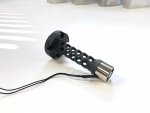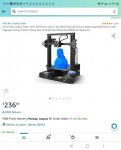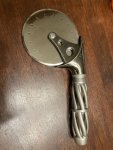I 100% agree I use glue every time but the Elmers purple glue haha. Not sure if it makes a difference. Great idea on two applications. I use a glass bed.Plain old Elmer's white school glue thinned out and applied in two coats (opposite directions of brushing) with a large flat brush has worked the best for me out of all the different adhesives I have tried, including Magigoo and other fancy ones. I also tried every white craft glue, none did very well. Elmer's stick is good for some simpler filaments like PLA, but for Nylon one needs very good hold, and Elmer's worked much better than any other for me. That is on both carbon lattice sheet and glass bed.
BDGR
-
Steel Soldiers now has a few new forums, read more about it at: New Munitions Forums!
Plan to buy a 3D printer
- Thread starter Bob H
- Start date

More options
Who Replied?HDN
Well-known member
- 2,291
- 5,564
- 113
- Location
- Finger Lakes Region, NY
I'm already running the bed at 100 deg C for ABS, so I don't have much, if any room left unless I can beef up the printer's power supply. I don't plan to do that any time soon. I'd rather have a print bed that heats evenly like it should. But Chinese quality will be Chinese qualityI only have adhesion issues with Nylons but my suggestion would be to heat the bed up an extra 5*C and see if that helps.
- 1,425
- 771
- 113
- Location
- Quantico VA
I have to run at 110C bed temp for common or exotic Nylon to have a chance. If you have a heated chamber that will also help with part flexion and reduce it trying to warp and pull off the bed (a little).I'm already running the bed at 100 deg C for ABS, so I don't have much, if any room left unless I can beef up the printer's power supply. I don't plan to do that any time soon. I'd rather have a print bed that heats evenly like it should. But Chinese quality will be Chinese quality
That said: Taulman Bridge nylon prints relatively well at modest temperatures (sub 100C bed and normal hot end 240C), and it is competitively priced. I have had good results with Taulman products in the past and have several Kg on hand.
My challenge in advanced nylon printing and related bed adhesion issues was self-imposed; I chose to print the cheapest 0.080" nylon weed wacker string I could get. It was VERY cheap, and it took MANY tries, but I suceeded in getting relatively large complex parts (relatively = 1.5" x 5" x 9") and I managed to sort the kinks out before I went even halfway through the first 5# spool (which cost about $25 at the time IIRC).
BDGR
- 6,160
- 4,882
- 113
So, I know absolutely nothing about 3d printing. I'd like to make stuff. I have downloaded some print files of some stuff I'd like to make.
What do I need besides filament, and what's pictured below?
What do I need besides filament, and what's pictured below?
Attachments
-
48.6 KB Views: 16
HDN
Well-known member
- 2,291
- 5,564
- 113
- Location
- Finger Lakes Region, NY
That's basically what I started with. If you want to learn some CAD stuff so you can print your own creations, let me know - I'm thinking about offering tutoring for Autodesk Fusion 360, which has a free license for hobbyists. I'd probably do it over Skype or something.So, I know absolutely nothing about 3d printing. I'd like to make stuff. I have downloaded some print files of some stuff I'd like to make.
What do I need besides filament, and what's pictured below?
What do you plan on printing? If it's models, PLA filament will work fine unless they're fish tank ornaments - PLA is biodegradable! If parts for stuff, ABS is a good material, but requires an enclosure that may need temperature control for best results.
Where do you plan on running the printer? Make sure you have enough fresh air circulating through the space or an air purifier since 3D printing puts some stuff in the air you may not want to breathe. My printer is enclosed in my shop with a small exhaust fan ducted outside.
peashooter
Well-known member
- 1,039
- 210
- 63
- Location
- Hanover, minnesota
I had a Anycubic brand DLP resin printer for a while and it printed fast and had nice resolution but the resin smell gave me bad headaches, plus having to clean the parts with an alcohol wash system followed by having to UV cure them, just got old.
I recently spent the money and got a Prusa mk3s+ and have to say it is ridiculously easy to use, ive never had a bad print…. Even my kids and wife can use it. Its 2-3x the cost of an Ender so it feels overpriced for what it is, but it might be worth the cost given the ease of use and reliability. FDM just isnt going to have as nice of resolution as resin, but the ease of use is awesome.
My favorite plastic material/process that i purchase from protolabs for work projects is HP’s Multi-Jet Fusion, using nylon. Formlabs makes a more affordable SLS system but I think its still in the $10k range so its out of the reach of most of us hobbyists.
I had bought and ran a metal printer at my prior employer and they were a lot of work, very cool but there is a long way to go before they will be replacing subtractive machining for standard products (obviously there are some things printers can make that machining never could, and vice versa). Most metal prints need to be cut from a build plate, supports need to be removed (probably the biggest pain), parts typically need 2 heat treat processes, and then you need to machine any critical features and abrasive blast and/or polish if you want a nice finish. Here is a pizza cutter handle i made for some friends when I was first learning to run it, (6000 layers of 17-4 stainless)
I recently spent the money and got a Prusa mk3s+ and have to say it is ridiculously easy to use, ive never had a bad print…. Even my kids and wife can use it. Its 2-3x the cost of an Ender so it feels overpriced for what it is, but it might be worth the cost given the ease of use and reliability. FDM just isnt going to have as nice of resolution as resin, but the ease of use is awesome.
My favorite plastic material/process that i purchase from protolabs for work projects is HP’s Multi-Jet Fusion, using nylon. Formlabs makes a more affordable SLS system but I think its still in the $10k range so its out of the reach of most of us hobbyists.
I had bought and ran a metal printer at my prior employer and they were a lot of work, very cool but there is a long way to go before they will be replacing subtractive machining for standard products (obviously there are some things printers can make that machining never could, and vice versa). Most metal prints need to be cut from a build plate, supports need to be removed (probably the biggest pain), parts typically need 2 heat treat processes, and then you need to machine any critical features and abrasive blast and/or polish if you want a nice finish. Here is a pizza cutter handle i made for some friends when I was first learning to run it, (6000 layers of 17-4 stainless)
Attachments
-
113.6 KB Views: 17
HDN
Well-known member
- 2,291
- 5,564
- 113
- Location
- Finger Lakes Region, NY
I was seriously considering a Prusa printer, but I didn't think the value was there compared to the Ender 5 Plus I bought, even though the Creality machine has the shortcomings of other Chinese-built printers out of the box. One thing about the Ender 5 family of Creality printers that I really like is that the bed only moves up and down in the Z direction with the nozzle going in the X and Y direction. That's one less movement that could topple a print over due to bed-slinging momentum, and I think it reduces the effect of vibration on the surface quality of the print.
A metal SLS printer is a dream machine of mine. I'd have to get enough work to pay for its cost, though. And the building it would be in. And its maintenance. Gosh it's sounding like owning a truck doesn't it? Except that involves a separate full-time job
Except that involves a separate full-time job 
@peashooter I was looking at the deuce dual-circuit brake cylinder bracket CAD file you and the other fellow whom I can't remember their screen name here. I was wondering how that would turn out on a metal printer, especially its durability compared to the original part.
A metal SLS printer is a dream machine of mine. I'd have to get enough work to pay for its cost, though. And the building it would be in. And its maintenance. Gosh it's sounding like owning a truck doesn't it?
@peashooter I was looking at the deuce dual-circuit brake cylinder bracket CAD file you and the other fellow whom I can't remember their screen name here. I was wondering how that would turn out on a metal printer, especially its durability compared to the original part.
peashooter
Well-known member
- 1,039
- 210
- 63
- Location
- Hanover, minnesota
Originally i had thought of trying to print some of the brake brackets but then we ended up changing our metal printer to a higher resolution system that had a smaller build area. It would definitely be a pricey print if you had to purchase it. I think the most affordable way to make one of those brackets would be a weldment, or buying a bracket from an A3 truck and drilling out the casting like another member did here https://www.steelsoldiers.com/threa...dual-circuit-brake-system.110705/post-1395495@peashooter I was looking at the deuce dual-circuit brake cylinder bracket CAD file you and the other fellow whom I can't remember their screen name here. I was wondering how that would turn out on a metal printer, especially its durability compared to the original part.
- 155
- 227
- 43
- Location
- North California, USA
I folks, I come from the additive manufacturing industry (3D printing being a form of it)
I’ve done quiet a bit of design and prints for aerospace, where 3D printing is definitely not a hobby - and these machines typically cost between 500K and $2M as a common price tag.
I still 3D print a lot, for hobby and mostly work, and most time using ABS-like resin.
My favorite affordable machines are the PRUSA SL1 (resin SLA) and the line of Creality CR-x (filament) I also have an Anycubic M3 Max which is quite tricky to get clean builds, but allows for the printing of large part. My plan with the anycubic for instance is to 3D print front headlights that will include UV spotlights and cameras. It takes a lot of learning and tuning but with patience, it pays off well.
One of our applications requires the using of plant-based resins made in the USA (for a gov funded project) and the results with the PRUSA are mind blowing, It looks like injected plastic parts.
I don’t know if the OP got an answer to his original question and if the goal was to produce plastic or metal parts? I’ve 3D printed parts in titanium, Inconel and aluminum that were near impossible to machine - additive manufacturing offers many possibilities.
A typical 4 hour print on the PRUSA:

Overall accuracy is less than 200 microns once the calibrations and compensations are understood, and this is made of plant based resin.
I’ve done quiet a bit of design and prints for aerospace, where 3D printing is definitely not a hobby - and these machines typically cost between 500K and $2M as a common price tag.
I still 3D print a lot, for hobby and mostly work, and most time using ABS-like resin.
My favorite affordable machines are the PRUSA SL1 (resin SLA) and the line of Creality CR-x (filament) I also have an Anycubic M3 Max which is quite tricky to get clean builds, but allows for the printing of large part. My plan with the anycubic for instance is to 3D print front headlights that will include UV spotlights and cameras. It takes a lot of learning and tuning but with patience, it pays off well.
One of our applications requires the using of plant-based resins made in the USA (for a gov funded project) and the results with the PRUSA are mind blowing, It looks like injected plastic parts.
I don’t know if the OP got an answer to his original question and if the goal was to produce plastic or metal parts? I’ve 3D printed parts in titanium, Inconel and aluminum that were near impossible to machine - additive manufacturing offers many possibilities.
A typical 4 hour print on the PRUSA:

Overall accuracy is less than 200 microns once the calibrations and compensations are understood, and this is made of plant based resin.
HDN
Well-known member
- 2,291
- 5,564
- 113
- Location
- Finger Lakes Region, NY
I recently bought an Elegoo Mars 4 DLP resin machine for printing miniatures and other stuff for scale modeling and doll houses. That thing makes phenomenal prints! I think it's worth the extra care needed with the resin and post-processing.
- 114,263members
- 167,171threads
- 2,353,553posts
- 7,451online users



